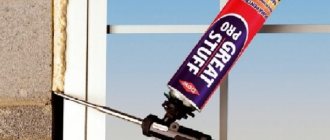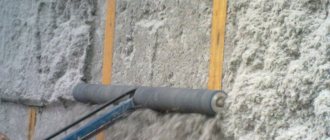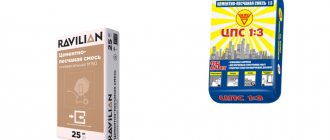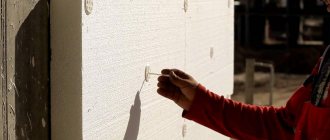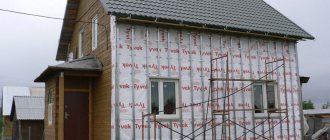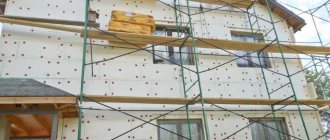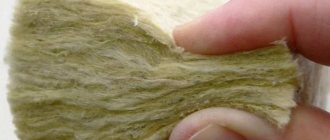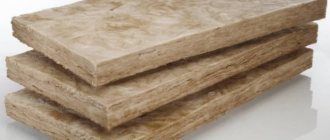Why do you need to insulate your house? Most likely, this question will cause confusion among many ordinary people.
A residential building must be insulated. If you reliably insulate a residential building, you will be able to create a stable internal microclimate at any time of the year. Thus, how comfortable the homeowner and all members of his family will live will not depend on temperature changes and the vagaries of nature. By also insulating the house, you will ensure reliability of all elements of the structure and increase their durability.
Before starting to build a private house, it is worthwhile to think through the issue regarding the insulation of not only the walls and ceiling, but also the entire structure. These activities can be carried out not only at the construction stage, but also during the operation of the building (this is best done in the warm season).
If a residential building has unsatisfactory thermal insulation performance, this will negatively affect not only the people living in the house, but also the building itself.
All members of your family will be susceptible to frequent colds. Life in cold rooms will not be comfortable. The walls of the house will be subject to freezing, and then the appearance of mold and mildew on them.
If all structural components of a building have increased thermal conductivity, this will cause self-destruction of building materials.
From the above, one conclusion suggests itself: a residential building needs to be insulated . And how this can be done must be decided by each homeowner individually.
You can insulate your house with one of these materials:
- mineral wool;
- Styrofoam;
- extruded polystyrene foam;
- penoplex;
- penofol;
- penoizol;
- polyurethane foam.
Foam for wall insulation: types and features
To insulate walls, modern craftsmen use various materials and technologies. They have significant differences among themselves, but they are all designed for the same purpose - to make the thermal insulation of the house as productive as possible.
IMPORTANT!
Polyurethane foam is considered one of the most effective materials used for insulation . This material will best protect against cold air entering the building.
Liquid foam for wall insulation is called polyurethane foam (PPU).
All the necessary ingredients are mixed at the factory and the composition required for polymerization is kept under high pressure in cylinders. In order for the foaming and hardening reaction to occur, contact of this composition with oxygen is necessary.
Insulation with polyurethane foam
Is it worth insulating walls with foam? Of course, it’s worth it for one simple reason - polyurethane foam is an ideal material for this purpose, and besides, it performs another very important function - sound insulation.
What is foam insulation? This is a special pliable mass that, when interacting with air, tends to foam. This composition has a fairly strong and elastic structure. To spray it, cylinders, pneumatic devices and other devices are used.
Today, when constructing frame-type houses, the areas between the “sandwich panels” are filled mainly with foam insulation.
Features of application
Thermal insulation by spraying polyurethane foam needs protection from the sun's harmful rays. That is, a light-proof finish must be applied on top of the applied layer. It is also undesirable to use flammable polyurethane foam for insulating wooden buildings. Despite the presence of fire retardant compounds in the mixture, the manufacturers failed to achieve absolute fire safety.
Another disadvantage of polyurethane foam is the toxic substances released from the foam during the polymerization process. So during work you need to use a good respirator and generally take care of your own safety. Well, the cost of insulation with polyurethane foam is very high, per 1 sq. m it ranges from 550-680 rubles with a layer of 5 cm. But polyurethane foam has a low thermal conductivity of about 0.019-0.028 W/m∙K and, if properly sprayed, can last at least 20-30 years. You can read more about working with such material in this article about polyurethane foam.
Main application steps
If you carry out insulation yourself by spraying polyurethane foam, you will need special equipment with a compressor and a pneumatic gun for the work. Ideally, this should be an automated foam generator that controls all mixing and supply parameters.
After this, you will need to order from the manufacturer a two-component composition for preparing PPU thermal insulation. In further work, follow the instructions:
1. Mix the first ingredient with a construction mixer to evenly distribute foaming agents, regulators, fire retardants and polyesters.
2. In a separate container, prepare a hardener - the second component of thermal insulation. If a precipitate appears in it, heat it to +70 °C, stir again and filter.
3. The combination of two ingredients must be carried out in a completely dry room, where foreign objects or substances cannot enter the mixture.
4. The finished thermal insulation is fed by a compressor into a special sleeve and applied from a gun to the surface to be treated under pressure.
Typically, the proportions of two-component mixtures are kept at 1:1, but the dosage should be checked with the manufacturer. The process of spraying insulation itself, judging by reviews, does not require any skills or complex training. Before insulation, you just need to clean the base from dust and loose pieces, and dry it thoroughly. Immediately after this, polyurethane foam is applied in a layer of 10-15 mm. A second pass is performed on an already frozen base.
Ecowool
This insulation is completely different from polyurethane foam, since it consists of natural components (cellulose), and is 40 percent cheaper. True, its thermal conductivity is higher - 0.032-0.041 W/m∙K. In our review, we will look at ecowool, which involves spraying using a wet-glue method. This is the most expensive, but also the most effective method of its use. The lucky ones living in areas where there are their own manufacturers of thermal insulation made from paper raw materials can count on the minimum price. To apply dry ecowool and the adhesive component, it is enough to dilute it with water in the correct proportion and use a pneumatic gun to spray it in a continuous layer over the surface. According to reviews, you can do without glue, but it is more reliable.
The density of ecowool is approximately 52-65 kg/m3, which guarantees its normal operation as insulation. But unlike polyurethane foam, it does not have proper moisture resistance, so it requires additional protection. However, with slight moisture (up to 14%), ecowool does not lose its properties - it “acts” like wood, releasing excess moisture rather than accumulating it. A really serious drawback is the flowability and shrinkage of the insulation - every year, cellulose insulation loses up to 1.2% of its original volume. Over 5-10 years of service, ecowool will sag by 6-12%, so manufacturers and craftsmen in their reviews recommend making a thicker layer.
When to use spray-on insulation:
1. Since spraying allows you to create a continuous layer, it is ideal for processing non-standard surfaces with protrusions, non-rectangular cells and irregularities.
2. This type of coating is indispensable for thermal insulation of any building structures with a large number of metal elements. Spraying polyurethane foam provides them with reliable protection from moisture penetration and subsequent corrosion.
3. For insulation of pipes and containers for various purposes.
Advantages and disadvantages of foam insulation
The main advantages of insulation:
- Possibility of processing even large areas in a short period of time.
- The coating has no seams.
- This material is not subject to rotting processes, and mold and mildew do not form on it.
- This is a highly flammable material that is not subject to combustion, it can only melt.
- By interacting with the metal coating, a dense anti-corrosion protection is created.
- The result is a smooth surface, which is characterized by excellent heat-saving properties.
- The foam does not deform the base on which it is applied.
- Light weight.
Regarding indicators such as environmental friendliness and durability, I would like to say the following: the material is absolutely safe for long-term use in residential premises.
Advantages of the material
Disadvantages inherent to this type of insulation:
- It is negatively affected by direct sunlight.
- The material may become unusable from continuous contact with water.
- The product is not cheap.
- To apply it, special conditions must be created.
- When working with foam insulation, you need to use a special tarpaulin suit, gloves, a respiratory mask and safety glasses.
- Since this material has a low level of vapor permeability, phenomena similar to those occurring in a thermos occur inside the building. Therefore, it is imperative to install a forced ventilation system for the premises.
Features of insulation application technology
The technology for installing sprayed insulation in cylinders involves the following steps:
- the cylinder is equipped with a special tube or gun, having first removed the lid;
- shake the composition thoroughly for at least 60 seconds;
- before applying foam thermal insulation, the surface is treated with water;
- The cylinder is held with the bottom up, the voids are filled to 1/3 of the volume, leaving room for expansion of the composition.
When the foam fills the entire volume of the gap, it is recommended to sprinkle the mass with water to improve the polymerization process. Curing time for foam insulation varies depending on the model and brand, and manufacturers produce products of varying quality. Surface hardening is observed within approximately 20 minutes after spraying. Correction of the mass using a cutting tool begins no earlier than after 4 hours. The full period of polymerization of foam floor insulation in cylinders requires a period of at least 24 hours.
Providing protective equipment
When applying polyurethane foam in cylinders for floor insulation, it is worth considering that the composition is poorly washed off from skin and clothing. You should work in protective clothing; it is also important to use safety glasses and gloves. Manipulations of spraying polyurethane foam with special equipment are performed using professional equipment to completely eliminate contact of the skin and mucous membranes with the substance.
When insulating a floor with foam, you need to use protective equipment
Thermal insulation of the floor by spraying
Installation of polyurethane foam when insulating floors using spraying technology involves the use of special installations. The foam insulator components are contained in separate tanks. The working composition is prepared directly on site before use. Substances enter the mixing device, are then sent to a spray gun and applied under pressure to the surface to be treated.
Features of installation of foam insulation:
- a frame structure is constructed for applying spray-on thermal insulation. Experts recommend lathing depending on the nature of the area being treated. For example, for effective thermal insulation of a wall structure, it is advisable to build a wooden or metal frame with an interval between guides of 30 cm. If you plan to insulate the floor with sprayed polyurethane foam, you should create a sheathing in increments of up to 1 m;
- the foam composition is applied by smoothly moving the jet over the surface to ensure uniform distribution of the mass;
- when processing vertical planes, foam insulator is sprayed from the lower perimeter, gradually filling the openings upward;
- When manipulating, keep the spray gun at a distance of at least 25 cm from the surface to be treated. When moving to another sector, you must release the gun trigger to block the stream.
If you plan to insulate the floor with two-layer spray foam, it is necessary to allow time for complete polymerization of the previous layer. After the mass has hardened, adjustments begin: cut off all protruding fragments with a sharp knife and level out any unevenness.
The flooring is laid after the foam insulation has completely polymerized.
Floor insulation by pouring method
The technology involves creating monolithic thermal insulation in the floor structure by pouring foam into specially made cavities. For example, a rough plank floor is constructed on joists, and small holes are made on the surface in designated areas for pumping polyurethane foam. If thermal protection of walls is planned by pouring polyurethane foam, the cladding is performed with a technical gap between the base and the finishing material. Next, the foam composition is poured through special holes on the facing panel.
Filling is carried out on the basis of the same spraying installations, reconfiguring the equipment parameters. In a professional environment, special units are also used for pouring polyurethane foam, which determines the high-quality level of thermal insulation work. The foam substance exclusively fills all voids down to the slightest cracks, resulting in the formation of a sealed thermal barrier with high performance characteristics.
What is the best way to insulate a building with foam - from the outside or from the inside?
It is difficult to give an unambiguous answer to this, but we will try to do so. One of the varieties of liquid foam, penoizol, is used for thermal insulation of frame buildings . This material fills the air gaps between:
- external and internal walls;
- wall and plastic panel;
- a wall and a sheet of drywall;
- subfloor and floor covering.
Insulation outside and inside
Using polyurethane foam, slabs made of solid thermal insulation materials are fixed, and the seams between them are also filled with foam.
Some homeowners use foam to insulate the facade of their building.
Polyurethane is used to eliminate minor defects on walls.
You will get an equally good result if you insulate the walls of frame-type houses, the roof, the attic, the facade of the house, as well as the basement and lower floor with polyurethane foam.
Major manufacturers of liquid insulation for buildings (structures) or utility networks
Today, a very large number of manufacturers have begun to produce ultra-thin liquid thermal insulation. However, many of them sell ordinary paint as liquid insulation. How to make the right choice? Let's look at this issue together and present a rating of the most popular manufacturers of this thermal insulation material.
Liquid thermal insulation Astratek
This material is produced by Russian. All products of the concern have appropriate quality certificates and a positive conclusion from the fire service and sanitary and epidemiological station. Liquid insulation Asstratek easily has the consistency of mastic and is easily applied with your own hands to any surface using a roller, sprayer or brush.
- It is not destroyed when exposed to precipitation because it has hydrophobic properties.
- There are no “cold bridges” unlike traditional insulation.
- Non-toxic and meets environmental standards.
- Does not support combustion, and is completely safe from fire safety.
- Completely preserves the architecture of the facade and does not steal useful space.
Liquid insulation RE-THERM
The insulation of this class consists of silicone and ceramic microspheres, which are located among a binder based on acrylic and latex. Thanks to this structure, this material has excellent waterproofing properties and, at the same time, high elasticity and particular strength.
The manufacturers of this product promise that the thermal conductivity of 1 mm of RE-THERM liquid insulation corresponds to 5 cm of mineral wool.
- This liquid insulation can be used on various surfaces, from concrete and brick to glass and plastic.
- Demonstrates ideal characteristics in the temperature range from −470 to 250 C.
- Quick drying, which ranges from 3 to 24 hours.
- High resistance to various mechanical influences, as well as to ultraviolet and infrared rays.
- Can be used both outside and inside buildings and structures.
VIOTERM Metal ALLUMA
This type of coating is specially designed for processing metal structures and engineering structures. Thanks to its structure, liquid insulation VIOTERM Metal ALLUMA gives the surface a glossy tint and reliably protects the surface from corrosion.
In addition to the above advantages, this ALLUMA coating perfectly retains heat in hot water supply and heating systems.
- It is used exclusively for treating metal surfaces as waterproofing.
- Demonstrates effectiveness at ambient temperatures from −50 C to 250 C.
- Low consumption, which is only 1 liter per 1 m2 with a layer thickness of 1 mm.
- When insulating water supply systems for hot water supply and heating systems, heat losses are reduced by 30%.
- The service life of this coating is 10-15 years.
Types of foam insulation: polyurethane foam and polyurethane foam
There are a large number of different types of foam materials on the market for construction needs; we will not consider them all in detail. For example, let's take just a few of them, which are considered the most popular and effective. We will talk about polyurethane foam and polyurethane foam.
NOTE!
Polyurethane foam is used to fill cracks and voids when installing windows and doors, as well as seams between floor slabs and joints of structural elements.
Polyurethane foam is used for:
- Achieve good sound insulation effect . To do this, fill the joints between pipes and holes in the wall with foam. Thus, it is possible to significantly reduce the noise level from the heating system, plumbing and operating air conditioners.
- Needs thermal and waterproofing . Using polyurethane foam, you can thoroughly seal cracks in the roof, voids around pipes, as well as empty space created as a result of installing door and window frames. The main purpose of polyurethane foam is sealing.
- Bonding . With its help, you can firmly connect various elements made of different materials to each other.
Polyurethane foam
PPU is produced in cylinders and has the following features:
- Polyurethane foam has excellent thermal insulation properties . Therefore, it is widely used as insulation and sealing material in construction.
- The properties of this material directly depend on the additives used in its production.
- Using sprayed polyurethane foam, you can easily and without any problems insulate a structure of any shape . The material is not afraid of dampness, it withstands the effects of acids and alkalis. It is also too tough for rodents and various insects.
Polyurethane foam
Briefly about the main thing
Insulating a house with foam has the following number of advantages:
- No load on structures.
- Seamless and hermetic filling of cavities.
- Biological resistance.
- Fire safety.
- Harmlessness.
- Creation of anti-corrosion protection for metal elements.
- Simple application procedure.
Disadvantages - high cost, low water resistance and sun protection, the need to use a protective kit during spraying. The most common types of foam insulation are penoizol, polyurethane foam, polyurethane foam and foam concrete.
The materials can be used both in liquid form and in the form of finished panels and blocks. The main purpose is to seal cracks and cavities, fill frame walls, insulate roofs, basements, floors, and facades. Thermal insulation can be done independently according to the instructions, but it is better to entrust the procedure to professionals.
Ratings 0
wall pie
Construction of a wall “pie” of a frame house:
- interior decoration;
- vapor barrier layer;
- insulation;
- frame stand;
- windproof layer;
- transverse lathing;
- vertical lathing;
- external finishing.
wall pie
If you plan to insulate the premises from the inside, you need to carry out all the work in stages. One of the main issues that you should pay special attention to is the correct placement of the vapor barrier film in the thermal insulation “pie”.
Vapor barrier can be made from:
- reflective film;
- diffusion membrane;
- steam condensate film.
When installing a vapor barrier material, you need to take into account one important point: it must be mounted on top of the insulation on the room side. If you plan to insulate the wall with polyurethane foam, then you will not need a vapor barrier.
Popular equipment, cost and characteristics
*
High-performance universal installations for spraying foam coating at a professional level cost hundreds of thousands of rubles. It makes sense to purchase them if you plan to open a thermal insulation business. They won't pay for themselves on just one house.
Household-grade devices are cheaper; they are divided into two classes:
Disposable
This is a factory assembled unit with charged components. Her virtues
- minimal preparation for work and ease of use;
- low price;
- After use there is no need for washing and preservation.
The disadvantages are:
- fixed volume of composition and, accordingly, area covered during use;
- An accurate calculation of the purchased kits is necessary - there may not be enough or there may be extra ones left.
It makes sense for novice craftsmen who do not want to waste time dealing with settings, refueling and maintenance of a reusable unit.
Rechargeable
This is a full-fledged complex for applying viscous coatings, which, unlike professional ones, has limited productivity and resource. They allow you to independently choose the type and density of the mixture, and charge the strictly required amount into the cylinders.
ProtonHome
- A popular rechargeable unit costs from 25 thousand rubles.
- allows you to spray coatings of any density,
- productivity - 2 kg of mixture per minute, which corresponds to 25-30 m2 with a thickness of 2 cm.
- the cost per square meter of coverage is approximately 560 rubles, the lowest among analogues.
- Cheapness results in the absence of fine adjustments of process parameters.
- A good choice for beginners.
Home installation Proton Home
Air-Light
A more productive (up to 4 kg of mixture per minute) universal rechargeable unit allows you to work both with built-in cylinders and to remove components from 100- and 200-liter barrels. Equipped with a frame and wheels for easy movement around the construction site. It is wise to purchase if large volumes of foam insulation are expected
Cost - from 80 thousand rubles.
Mobile installation AirLight
Foam Kit 600
Kit for applying 56 m2 of coating, disposable, pre-configured.
Disposable Foam Kit 600
Costs from about 35 thousand rubles, the kit includes everything you need to apply the composition charged into the cylinders, including replacement nozzles for the gun and protective gloves.
Installation of lathing and applying foam yourself
It is necessary to screw an aluminum profile to the ceiling and walls in vertical rows . Next, the sheathing is strengthened using horizontal jumpers ( steps of 0.5 meters ). Don't forget to screw the profile around the perimeter of the window doorway.
In order not to stain pipes and communications, they need to be covered with film .
Installing the sheathing
Rules for applying foam insulation in cylinders:
- First of all, you need to take care of safety precautions.
- Then you need to spray a small amount of automotive silicone grease onto the mounting gun.
- Next, you need to insert the can onto the gun and screw it tightly.
- Now you can apply the mounting foam to the desired location.
- The can must be removed from the gun and cleaned with a special compound.
- If the foam is not completely used up, you need to wash the valve located on the cylinder with a cleaner.
Applying foam to wall surfaces
Is it possible to insulate a house with foam yourself?
Most often, they carry out work related to the internal insulation of the house with their own hands. For this you will need:
- Wood slats or metal profiles as guides for sheathing.
- Construction gun and balloon foam.
- Knife with a sharp blade.
The surface to be treated must first be cleaned of dust, cobwebs, mold and other contaminants. Then you can begin fixing the sheathing profiles. The gaps between them should be 50 centimeters. They are mounted vertically on the wall, additionally fastened with horizontal jumpers at the same distance. If there is furniture left in the room, it is recommended to cover it with film. The eyes are protected with goggles, the body and hands are protected with a suit and gloves, respectively. The further procedure looks like this:
- It is recommended to treat the construction gun with automotive lubricant.
- The can is inserted into the gun, and you can begin treating the surface with foam.
Installation of metal or wooden beams
Before installing the sheathing, the surface will need to be prepared - remove cobwebs and dust, remnants of the old finishing coating, cement, etc. A deep penetration primer is applied to the cleaned surface with a roller or spray. It will create a thin protective film.
The slats or profiles are fixed in increments of 50 centimeters, installing horizontal jumpers to increase strength also every half meter. Depending on the base material, suitable hardware is selected. These can be anchors or dowels
Before installing the insulation, it is important to provide in advance places for laying electrical cables or other utilities
Spraying foam using a compressor
First of all, the heat insulator is applied to problem areas - with cracks, joints and crevices. In this way, it will be possible to get rid of voids that could become cold bridges in the future. Next, the voids are filled in those places where the sheathing is adjacent to the insulated surface. You need to spray the polymer insulation from side to side, movements should be sweeping and even. They are produced from top to bottom. When treating a metal surface, it is recommended to pre-clean it from rust, as well as treat it with a corrosion-preventing agent.
It is important not to allow the sheathing to be completely covered with the composition.
Drying
The material begins to foam while still inside the compressor. Once applied to the surface, it will harden in approximately 15-20 minutes. It will take at least a day to dry completely, and if the layer is thick, then three days. It is recommended to begin final finishing after five days.
Alignment
Before finishing, the surface must be carefully leveled. It will be enough to cut off the excess frozen foam with a sharp knife. The heat insulator must be flush with the sheathing beams
It is important that the coating is smooth, without bumps or depressions. Sometimes it can be difficult to work with just one knife
Then you can use a hacksaw with a fine tooth. After all manipulations, the finishing material can be fixed to the surface.
Finishing
Foam insulator is not suitable for subsequent plastering, puttying, or wallpapering. Here is a list of suitable facing materials:
- plasterboard sheets;
- panels made of wood, glass or plastic;
- wooden lining;
- OSB or fiberboard sheets.
Waterproofing
Polyurethane foam is also used for waterproofing. It increases in volume under the influence of moisture and hardens within 24 hours.
Polyurethane foam with waterproofing properties is sold in cans. It is endowed with high waterproofing and fixing properties. It is used for both external and internal work.
This universal material is not afraid of water and high humidity, so it is widely used in everyday life.
How they insulated my wall with foam insulation and how it all ended
Good afternoon to my readers.
I've been absent from the blog for quite some time. And all because events have unfolded over the past two weeks that have occupied all my thoughts and time. This is what I will talk about in today’s notes. With the beginning of summer, the family resumed debate about insulating the furthest room in the house. It really is a couple of degrees colder. True, the wife claims that she is also pulling from somewhere in the upper corner. I don’t feel any drafts, the wall is just cool. Be that as it may, it was decided to insulate the walls. The disputes were regarding the technical side of the issue.
Insulating the outside of the house with mineral wool followed by siding was rejected due to the lack of the required amount of money for this type of work. Insulation from the inside, also with mineral wool, vapor barrier and covering the walls with plasterboard, was the last thing I considered (it risks a total renovation of the room, the presence of suspended ceilings and a reduction in the usable area of an already small room). And here, like a lifesaver, an advertisement from a newspaper about insulating houses (as well as all conceivable building structures) with foam insulation .
For reference. Penoizol is a polymer foam, a kind of liquid foam (components: water, foaming agent, acid, hardening resin), which is used to fill cavities in building structures, between walls. Many advantages and few disadvantages. And so on and so forth... I won’t describe it for too long. Those interested can type in the search (Yandex knows everything) and see what kind of animal this penoizol is.
That's it, I think. This is salvation for me! I called the ad, talked, found out in advance what the insulation was, how the work was carried out, prices, and so on. The next day, a representative of the “insulation” team arrived and inspected the scope of work on site (that is, my house), estimated the volume of work and we parted, promising to call as soon as he had time free from regular orders.
And then at the end of July comes D-Day. An installation crew of three people drives into the yard in a GAZelle, which carries all the props necessary for the work. A compressor, piles of coiled watering hoses, wires, buckets, watering cans, a large rusty barrel... it all looked like a bunch of junk. Honestly, I somehow imagined everything a little differently, but you never know. Maybe I just don't know anything about the latest nanotechnology.
The work didn't work out right away. Something was constantly getting lost, something didn’t work or broke along the way. Either the extension cord is burned out, then the compressor does not produce the required pressure, then the bucket is leaky, then the taps are leaking... in short, everything is not thank God. They agreed that they would go home to repair the compressor (as soon as they do it, they will come). Two days later they arrive with a new compressor, well, now things will go smoothly. I suspected something was wrong when all the workers had been running after each other for more than half an hour, turning the taps on the pressure gauges and blowing into the hoses. Well, I ask. But the problem is, the mixer and all the filters in it are clogged, just clean it and rinse it with acetone. In short, they untwisted the ill-fated mixer, jumped into the car and rushed home. On the third visit, the solution refused to foam properly, they say the foaming agent had deteriorated due to the statute of limitations. Let's go get the foam concentrate. I was already getting tired of this, but my wife grabbed my hands, begging me not to kick them out, as I had planned. Because no one else in our little town is engaged in such a cunning occupation and there is no one else to work with. Okay, this will be their last chance.
The last chance was provided for a very long time. Where they disappeared to for a week and a half remained a mystery to me until the very last day. Their phones stubbornly did not answer, all their accessories were in the gazebo and I began to get more nervous than usual. When, one fine sunny morning, they answer the call and, as if nothing had happened, they declare that he was driving to Belarus to get a car and they had no time. And now they are rested and ready to continue working.
In response to my angry reproaches and indignation, the workers began to sniffle offendedly and considered themselves unfairly offended. Silently they unsheathed their vacuum cleaners and pumps, mixed the paste and got to work. I sit next to them and watch their activities. It doesn't seem to be suspicious yet. Foam pops and cheerfully climbs out of the holes in the wall, which the craftsmen quickly plug with their fingers and newspapers. Two hours later, when a third of the holes in the walls had been used and plugged, the workers informed me that they say that the water has run out. The water used was not just any kind, but river water, hard, so that it would not foam so abundantly. And the barrel, as luck would have it, remained on another farmstead in a neighboring city. We'll come tomorrow, bring fresh river water and finish it all. I just nodded silently, because I was simply tired of swearing.
Conclusion
Foam insulation can be used for walls made of various materials, including aerated concrete, blocks and reinforced concrete panels. Therefore, they are used for insulation of private cottages and apartments. Before giving preference to any one type of foam, consult a specialist.
If you have decided to insulate your house with liquid foam, this is the right intention. Always try to buy raw materials from the best domestic and foreign manufacturers. This way you will be able to avoid premature wear of structures.
Material characteristics
Polyurethane foam (PPU) looks like a homogeneous structure of foam material, consisting of air bubbles filled with gas. Various versions of polyurethane foam are deservedly popular because they can be manufactured directly on the construction site. The most common method is to apply the material to the surface by spraying. Spraying is used for thermal insulation of houses, industrial workshops, pipelines, and in addition, it is actively used in the interior of premises.
Filling is used when it is necessary to fill a cavity between walls or a gap between installed finishing layers.
The thermal conductivity coefficient of the material is 0.023-0.025 W/mS. Teplis heat insulator is lightweight and can be easily applied to surfaces made of any materials (concrete, brick, glass, wood, aluminum, PVC).
Thanks to the optimal ratio of open and closed cells in the structure, the insulation “breathes”. Accordingly, the treated surface always remains clean and dry.
Other product benefits include:
- resistance to temperature changes;
- environmental friendliness;
- duration of operation (at least 20 years);
- seamless application, eliminating the formation of cold bridges;
- good sound insulation;
- low flammability;
- immunity from harmful rodents and insects.
Teplis polyurethane insulation is sold in 1 liter cylinders. Included with this product, the manufacturer offers to purchase a mounting gun with nozzles for uniform spraying.
Basement of a house with sprayed insulation applied
Tips and tricks for use
The use of foam heat insulators requires a preliminary analysis of surfaces, their operating conditions and the degree of vapor permeability. This is an important point, since errors in the choice of material can lead not only to the opposite effect, but also to the destruction of walls or other structures of the house. You need to learn the rule - foam can only be applied to impermeable materials, for example, metal roofing or OSB (if a frame house is being insulated). In such cases, it does not matter whether the material is applied internally or externally.
If foam must be applied to permeable walls (concrete, brick, cinder block, etc.), then external insulation with polyurethane foam or other types of foam is prohibited (with the exception of permeable penoizol). If you plan to install foam from the inside, you must immediately provide high-quality ventilation to remove moist air.
Sometimes it is mistakenly believed that foam cannot be installed only in heated rooms, and for unheated rooms this restriction does not apply. Therefore, insulation of an attic or other similar area of the house can be done in any way you like, the main thing is to carefully and evenly apply a continuous layer of foam.
This belief becomes the cause of serious mistakes, leading to the need to redo the work or create additional systems and conduct communications. It is necessary to take into account that insulation of unheated rooms is useless in itself, since there is no thermal energy that must be conserved.
Which variety to choose
In many ways, the choice will depend on the specific situation and what area needs to be treated. Using an example, we can consider the most common cases when a house needs foam insulation:
- If you need to seal cracks or eliminate any other defects on the surface, then polyurethane is suitable. But such material should not be exposed to sunlight.
- If you need to fill a large volume, then penoizol is suitable. But an ordinary cylinder will not be enough; you will need to purchase a special device with high pressure. You don’t have to buy it at all - you can rent it or borrow it from friends, because no one will use it often.
- If you need to seal small cracks and carry out thermal insulation in small areas, you can buy a cylinder with regular polyurethane foam. It does not support combustion, after hardening it is particularly hard, and it has an ecological composition.
- If defects are found on the outside of the wall, then you need to apply a composition based on polyurethane. It is applied directly using a special cylinder or apparatus.
It is worth remembering that foam insulation creates errors inside the layer that need to be eliminated. To do this, you will need a long hose to push the material inside. If it is necessary to fill air gaps inside the insulation, then holes are made in the wall with something sharp.
Polyurethane foam is not suitable for insulating the entire external facade - it does not have the appropriate characteristics necessary for this. Therefore, you should not choose it for these purposes, even despite its more economical cost.
Some important tips
Before you choose this material and start insulating walls with foam, you should take into account useful tips for choosing and working with insulation
Let's consider in what cases and how best to insulate walls.
For dealing with cracks on the exterior walls of a home, the polyurethane foam type is ideal. It can also be used to insulate the floor if it is an open veranda, and also for insulating the attic. But if you decide to make a room out of the attic where you plan to spend a lot of time, or the windows face the sunny side, then it is not recommended to use polyurethane foam there either.
If you plan to fill a large space with foam or fill it, then the use of penoizol will be indispensable. But don’t forget about purchasing a special spraying apparatus, because... a regular bottle won't be enough.
If you need to repair cracks and other defects in the wall or provide thermal insulation in small areas, then it is better to insulate the house with polyurethane foam in cylinders. This non-flammable insulation is environmentally friendly and becomes quite dense after final hardening.
There is one more tip about applying foam. If it is necessary to repair external defects, then the technology of applying foam is direct - using a balloon or a special apparatus. But if defects are found in the thickness, then it is necessary to use a long hose to push the foam. Just before doing this, you should drill a couple of holes in the wall.
Cylinder assembly
It is best to carry out insulation with this type of insulation in small areas, because its use in large areas is not always economically feasible.
The reason here is that polyurethane foam is sold mainly in small volume containers, approximately 200 and a maximum of 750 ml.
The largest of them are inexpensive, but they are enough to process only 1 square meter. m of any surface, but taking into account that the layer will be applied no thicker than 8 cm.
After insulation with this material, the thermal insulation of the surface will be several times lower in comparison with the use of the other two types of foam. The reason is that in such insulation half of the cells remain open, whereas in the same polyurethane foam the number of closed pores reaches 90%.
The process of foaming polyurethane foam occurs due to the fact that it is supplied to the surface under high pressure.
In addition, this process intensifies after the material reacts with moisture in the air.
The use of this insulation is common for sealing both window frames and during the installation of doors. It is also advisable to insulate the walls of a small area, for example, a loggia or closed balcony.
This insulation has a more complex composition than classic polyurethane foam.
It is produced in the form of slabs, which is somewhat similar to classic polystyrene foam.
Being in this form, it is more protected from external factors for storage and transportation.
But to bring it into a liquid state at the point of use, a special device is used. It not only melts penoizol, but also mixes it with resin. When insulating walls using such insulation with your own hands, you use a special construction gun.
Foaming begins inside this device and then it is applied to the surface, where it hardens after 15 minutes. For the material to completely harden, you need to wait several days.
Due to the fact that it has a long period of complete hardening, brick-type walls are most often insulated with foam insulation. The material is also often used for thermal insulation of formwork, as well as for insulation of frame houses.
Good to know: due to the fact that the composition of penoizol includes urea and formaldehyde, a significant number of people believe that this insulation is harmful to health. In fact, this is not so, all these components are removed, so the material is harmless to people.
Polyurethane foam
From a technical point of view, everything will be much simpler here. The composition will be mixed from two ready-made components and the whole process will be much easier. It is necessary to observe the proportions of liquid compositions entering the mixer and monitor the pressure provided by the compressor. The remaining precautions will be the same as in the previous case - you can easily destroy fragile brickwork with foam, which can expand forty times.
The cost of the material in this case will be higher, but it will be easier to work with and the quality of the insulation will be at a high level. It is important to ensure that the voids are filled evenly. At the same time, during the polymerization process, this composition will release significantly less formaldehyde compounds than in the situation with penoizol, and the time for complete hardening of the foam will be reduced several times.
Regardless of the chosen option for foam insulation, you need to remember that there are no harmless compounds of this kind. All of them will release formaldehyde during the polymerization process. Therefore, while the foam dries, it is better to leave the house empty and not live in it. It will take a couple of days or even a week, but you are guaranteed to protect yourself and your loved ones from poisoning. In this regard, penoizol performs worst of all, which can dry in open spaces for up to thirty days - depending on the proportions of mixing the components and the quality of the raw materials.
Manufacturers and prices
There are many manufacturers of foam thermal insulators. This is a modern, promising material that is of interest to all specialized companies. Among the leading manufacturers are:
- VASmann;
- Sipur;
- Polynor;
- Penoplex;
- TechnoNIKOL;
- Profur;
- Penosil, etc.
VASmann
Sipur
Polynor
Penoplex
TechnoNIKOL
Profur
Penosil
Listing manufacturers will not provide useful information, since there are many of them and they all produce a large number of varieties of foam for insulation. Prices for the material vary - polyurethane foam costs about 3000-5000 rubles per cubic meter, foam in liter cylinders costs from 350 to 550 rubles. If you order application from specialized organizations, the costs will be even higher, since the price of work and overhead costs will be added to the cost of the material. However, this option is considered more preferable, since the work will be performed by specialists who guarantee the result.


